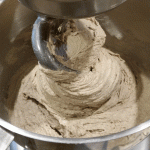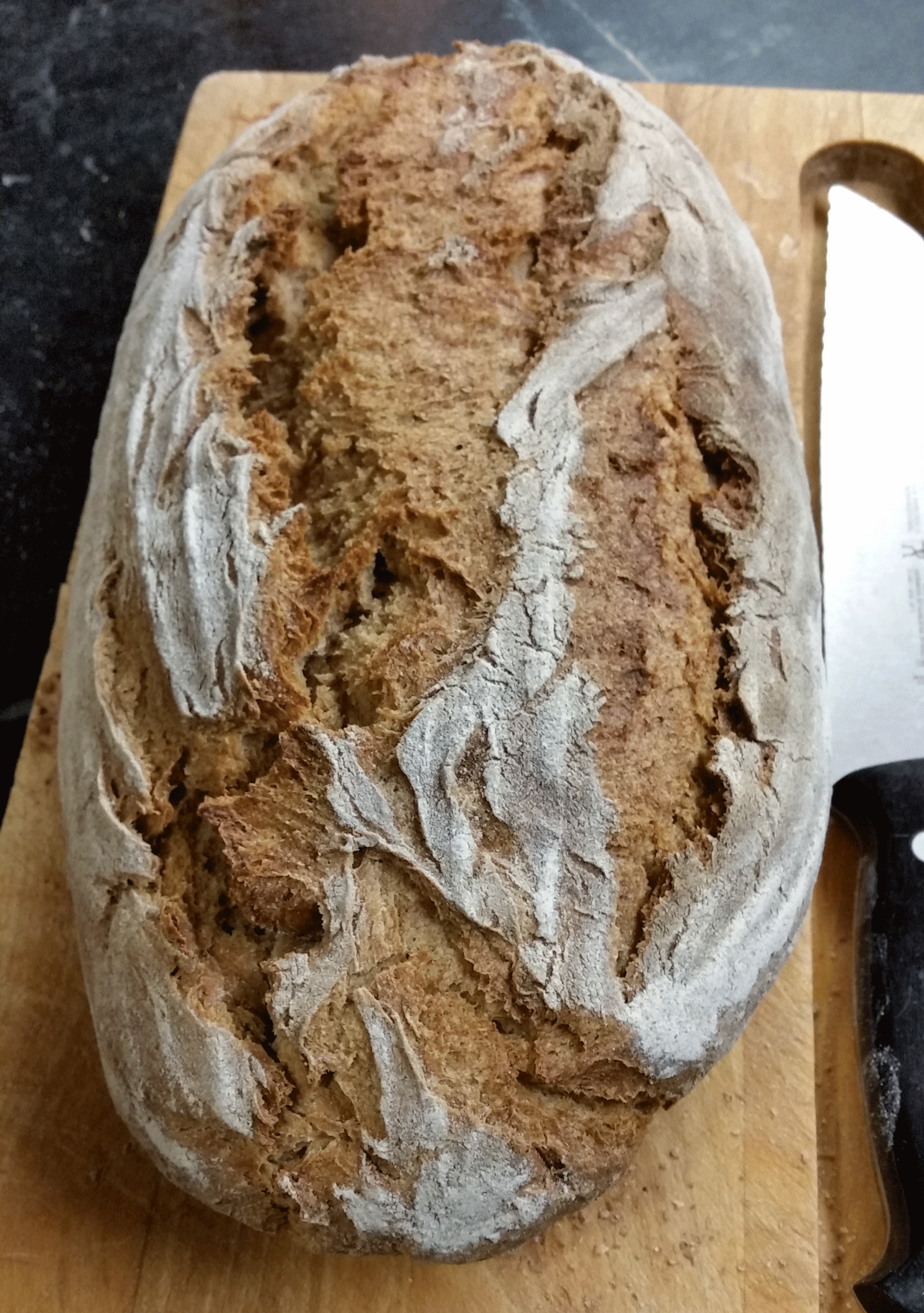| Rye %: | 60% |
| Stages: | Monheimer Salt Sponge, Final dough |
| Leaven: | Rye sour culture, Instant yeast |
| Start to Finish | 16-18 hours |
| Hands-on Time: | 30-4o minutes |
| Yield: | Two 34 oz. (965 g.) loaves |
Pinzgau is in western Austria, bordered by Bavaria to the north, Switzerland to the west and alpine Italy to the south. Like most of the Alpine regions, its breads are typically mixed wheat and rye, and the rye flours are lighter than those in the north. Here, too, the use of bread spice (brotgewürz) – a 10-6-6-2 blend of caraway, anise, fennel and coriander, toasted and ground fine – is common, adding subtle notes of astringent, sweet and citrus to the breads.
Pinzgauer, like so many European rye breads, has many variations. I adapted this one from Björn Hollensteiner, a physician and hobby baker who’s also one of Germany’s best-known bread bloggers (brotdoc.com). He, in turn adapted it from Lutz Geissler (www.plötzblog.de) another of Germany’s premier bread bloggers.
This version is interesting because it uses a Monheimer salt sponge, which intensifies the acidity of the bread while keeping the yeast in check by adding 1% salt to the 80% hydrated sponge. And where Björn’s version calls for Type 1050 (first clear) flour, I substituted bread flour in order to get a more open crumb. I also increased the length of his bulk ferment from 30 to 90 minutes in order to give the gluten more time to develop and to open the crumb somewhat. Proofing it seam-side down means that when the loaf gets flipped onto the baking stone, it develops a beautiful bloom in the crust.
I ended up with a lovely, crusty bread that features a tender crumb that’s quite open for a 60% rye. The strong flavor of the medium rye is somewhat muted by the white rye flour (in Germany and Austria, they use a mild, semi-white flour, Type 997, for this bread), while the Monheimer sponge lends a bright, yet subtle sour. After sampling the heel of the bread unadorned, I had it with Dijon mustard and roast beef, and then separately with mayonnaise and honey-roasted turkey breast. Every way I ate it, it shone.
Monheimer Salt Sponge
| Ingredient |
Grams |
Ounces |
Baker’s |
| Medium rye flour |
315 |
11.10 |
100% |
| Warm (105°F/41°C) water |
255 |
9.00 |
81% |
| Salt |
3 |
0.10 |
1% |
| Rye sour culture |
32 |
1.15 |
10% |
Combine the sponge ingredients and hand-knead until they come together as a firm, dough. Cover and ferment at room temp (70°F/21°C) until doubled in volume, 12-14 hours or overnight (original volume marked by the rubber band).
Final Dough:
| Ingredient | Grams | Ounces |
| Bread flour |
520 |
18.35 |
| White rye flour |
260 |
9.15 |
| Medium rye flour |
210 |
7.40 |
| Water |
635 |
22.35 |
| Salt |
26 |
0.90 |
| Instant yeast |
4 |
0.15 |
| Bread spice |
7 |
0.25 |
Combine the final dough ingredients in the bowl of the mixer. Use the dough hook at low (KA2) speed and mix until the dough is evenly developed and leaves the sides of the bowl, 6-8 minutes.
Smooth the dough, cover the bowl and ferment at room temperature
until the dough has doubled in bulk, 90-100 minutes.
 Turn the dough, which will be sticky and soft, onto a well-floured work surface and use floured hands to knead it back to its original volume. Divide it into two pieces, each weighing about 2½ lb./1.15 kg. Shape each into a boule or oblong, dust generously with rye flour, and place seam side down into a floured bread form or cloth-lined proofing basket.
Turn the dough, which will be sticky and soft, onto a well-floured work surface and use floured hands to knead it back to its original volume. Divide it into two pieces, each weighing about 2½ lb./1.15 kg. Shape each into a boule or oblong, dust generously with rye flour, and place seam side down into a floured bread form or cloth-lined proofing basket.
Cover and proof at room temperature until the surface of the dough starts to show cracks and has nearly doubled in volume, 45-50 minutes.
Preheat the oven to 485°F/250°C with the baking surface in the middle and a steam pan on a lower shelf. Bake for 10 minutes with steam, then remove the steam pan, reduce the temperature to 430°F/220°C and bake until the loaves have develop a rich brown color, thump when tapped with a finger and the internal temp is at least 198°F/92°C, 45-50 minutes. Transfer to a rack and cool thoroughly before slicing.
Baker’s Percentages:
| Ingredient |
g |
% |
| TOTAL FLOUR |
1,305 |
100.00% |
| Medium rye flour |
525 |
40.23% |
| Bread flour |
520 |
39.85% |
| White rye flour |
260 |
19.92% |
| Water |
889 |
68.12% |
| Salt |
29 |
2.22% |
| Instant yeast |
4 |
0.31% |
| Sour culture |
32 |
2.45% |
| Bread spice |
7 |
0.54% |
| TOTAL FORMULA |
2,266 |
173.64% |
| % flour prefermented | 315 | 24.14% |








Michiel Eldering
February 2, 2016Thank you so much for sharing. Lovely bread. I begin to understand why law salt percentages areb often used in rye breads.
Steve Carlson
February 2, 2016The bread looks delicious! Thanks for the great info and photos. ONE QUESTION; what is bread spice and where do you get it?
Stanley Ginsberg
February 2, 2016As noted in the bread description, bread spice is a blend of caraway, anise, fennel and coriander in the ratio of 10-6-6-2, toasted and ground fine. I make my own.
Karin Anderson
February 6, 2016Lovely loaf! The ratio of spices in “Brotgewürz” can vary from region to region, and coriander is not always included. In Northern Germany they use mostly caraway, anise, and fennel.
Sadly, one of the signature Alpine bread spices, Schabzigerklee (or Brotklee) = BLUE fenugreek – is not easy to find in the US. (I brought some from Germany).
Stanley Ginsberg
February 6, 2016I use Indian fenugreek leaves (methi) as a substitute for brotklee. It’s not exact, but very close, imparting a wonderful sweet, grassy fragrance to my South Tyrolean breads. You can find it in Indian groceries or online.
Karin Anderson
February 6, 2016I don’t think the Indian brown fenugreek tastes similar.
I did once a taste test baking Vinschger Paarlen with the two kinds of fenugreek and, what Wikipedia suggested as possible substitute, dried nettle leaves (stinging nettle) and curry.
Wikipedia was right: 1 tbsp ground nettle leaves plus 1 tsp curry came very close to Schabzigerklee, the regular brown fenugreek is more acidic and has a different taste.
Stanley Ginsberg
February 7, 2016I’m not talking about the seeds, but the leaves, which are a dark green color and are very similar in flavor to the stinging nettle/curry mixture you describe.
Karin Anderson
February 8, 2016Interesting, thanks for the information, Stanley, I didn’t know there were leaves available, too.
John Jacobson
January 20, 2019Is it possible to grow alpine (blue) fenegreek in the upper Midwest, and if so, does anyone have a seed source?
FC Daisy
January 25, 2019Uprising Organics sells blue fenugreek seeds:
https://uprisingorganics.com/herbs/blue-fenugreek.html
They grow well in the Pacific Northwest